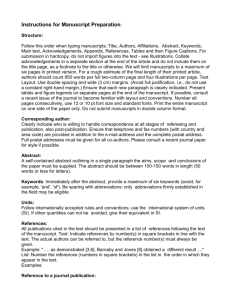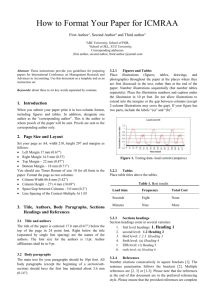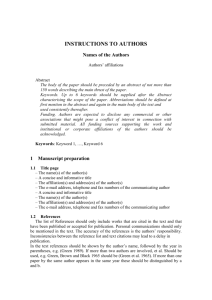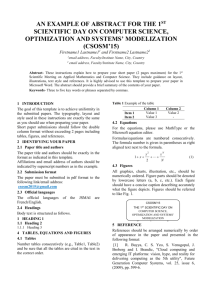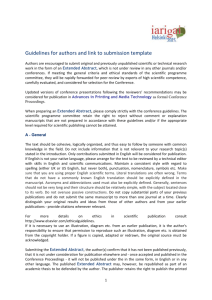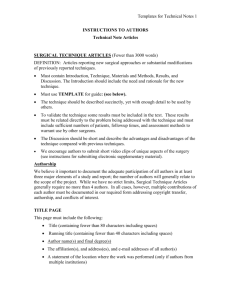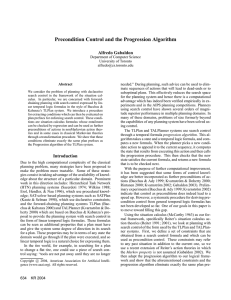psccpaper
advertisement
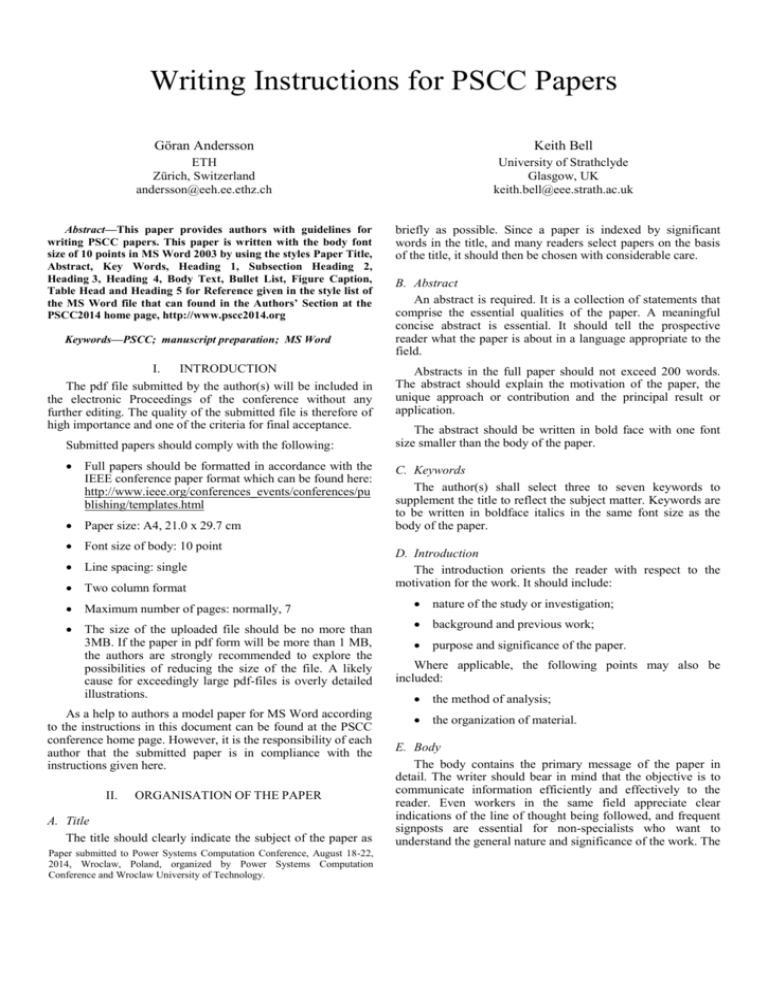
Writing Instructions for PSCC Papers Göran Andersson Keith Bell ETH Zürich, Switzerland andersson@eeh.ee.ethz.ch University of Strathclyde Glasgow, UK keith.bell@eee.strath.ac.uk Abstract—This paper provides authors with guidelines for writing PSCC papers. This paper is written with the body font size of 10 points in MS Word 2003 by using the styles Paper Title, Abstract, Key Words, Heading 1, Subsection Heading 2, Heading 3, Heading 4, Body Text, Bullet List, Figure Caption, Table Head and Heading 5 for Reference given in the style list of the MS Word file that can found in the Authors’ Section at the PSCC2014 home page, http://www.pscc2014.org Keywords—PSCC; manuscript preparation; MS Word I. INTRODUCTION The pdf file submitted by the author(s) will be included in the electronic Proceedings of the conference without any further editing. The quality of the submitted file is therefore of high importance and one of the criteria for final acceptance. Submitted papers should comply with the following: Full papers should be formatted in accordance with the IEEE conference paper format which can be found here: http://www.ieee.org/conferences_events/conferences/pu blishing/templates.html Paper size: A4, 21.0 x 29.7 cm Font size of body: 10 point Line spacing: single Two column format briefly as possible. Since a paper is indexed by significant words in the title, and many readers select papers on the basis of the title, it should then be chosen with considerable care. B. Abstract An abstract is required. It is a collection of statements that comprise the essential qualities of the paper. A meaningful concise abstract is essential. It should tell the prospective reader what the paper is about in a language appropriate to the field. Abstracts in the full paper should not exceed 200 words. The abstract should explain the motivation of the paper, the unique approach or contribution and the principal result or application. The abstract should be written in bold face with one font size smaller than the body of the paper. C. Keywords The author(s) shall select three to seven keywords to supplement the title to reflect the subject matter. Keywords are to be written in boldface italics in the same font size as the body of the paper. D. Introduction The introduction orients the reader with respect to the motivation for the work. It should include: Maximum number of pages: normally, 7 nature of the study or investigation; The size of the uploaded file should be no more than 3MB. If the paper in pdf form will be more than 1 MB, the authors are strongly recommended to explore the possibilities of reducing the size of the file. A likely cause for exceedingly large pdf-files is overly detailed illustrations. background and previous work; As a help to authors a model paper for MS Word according to the instructions in this document can be found at the PSCC conference home page. However, it is the responsibility of each author that the submitted paper is in compliance with the instructions given here. II. ORGANISATION OF THE PAPER A. Title The title should clearly indicate the subject of the paper as Paper submitted to Power Systems Computation Conference, August 18-22, 2014, Wroclaw, Poland, organized by Power Systems Computation Conference and Wroclaw University of Technology. purpose and significance of the paper. Where applicable, the following points may also be included: the method of analysis; the organization of material. E. Body The body contains the primary message of the paper in detail. The writer should bear in mind that the objective is to communicate information efficiently and effectively to the reader. Even workers in the same field appreciate clear indications of the line of thought being followed, and frequent signposts are essential for non-specialists who want to understand the general nature and significance of the work. The use of Trade Names, Company Names, and Proprietary Terms should be avoided. Equations should be labeled consecutively in Arabic numbers in brackets, (1) etc.: ab F. Conclusion The conclusion should be clearly stated, and should cover the following: what is shown by this work and its significance; limitations and advantages. Where applicable, the following points should also be included: applications of results; recommendations for further work. G. References References are important to the reader; therefore, each citation must be complete and correct. References should be commonly available publications; references to reports of limited circulation should be avoided. References to unpublished work or work not properly indexed should not be used. References to books and papers by authors other than the author of the paper are encouraged. The formats of references are illustrated in the examples in the section References at the end of this paper and in the template provided in the Authors’ Section at the PSCC conference web page. The reference section should appear at the end of the paper. The square brackets are used to distinguish references [1] from equation numbers (1). With an exception for survey-type or state-of-the art papers, it is recommended to limit the number of references to 10. III. PREPARATION OF MANUSCRIPTS A. General All manuscripts must be prepared in a prescribed format of 21.0 x 29.7 cm (8 ¼ x 11 ¾ in), i.e. A4- paper. Two-column originals must be used. These writing instructions are an example of a correctly prepared manuscript. Manuscripts, including illustrations, photographs, and references, are normally limited to seven (7) pages. Manuscripts which are accepted, but which exceed seven pages in length may be subjected to an excess charge of 100 EURO per page. At most three additional pages are accepted. B. Typing Requirements The paper should follow the template provided in the in the Authors’ Section at the PSCC conference web page. References must be numbered consecutively and put in the last section headed by REFERENCES without any number. C. Figures and Tables Figures should fit a one or two column width. Place figures at the top and bottom of columns Captions should be typed single-spaced and placed under the illustrations and should be font size 8. Figures should be numbered consecutively with Arabic numbers. Use the abbreviation “Fig. 1,” even at the beginning of a sentence. We suggest that you use a text box to insert a graphic (which is ideally a 300 dpi resolution TIFF or EPS file with all fonts embedded) because this method is somewhat more stable than directly inserting a picture. To have non-visible rules on your frame, use the MSWord “Format” pull-down menu, select Text Box > Colors and Lines to choose No Fill and No Line. Fig. 1. Example of a figure caption. Figures could be in black and white or in color. Photographs must be clear. Identification as to affiliations should not appear on illustrations. The lettering on all illustrations, charts, and tables must be legible. Even if color illustrations are allowed, it should be remembered that the paper should also be printable on a non-color printer without essential information being lost. Diagrams and graphs should not contain too many different curves. Make sure that the different quantities plotted are distinguishable and easy to identify either by text in the figure or by the explanation in the figure caption. Make sure that text in figures is not smaller than font size 9 in final format. The authors must be careful not to overload illustrations with too many, or confusing data. This may also increase the size of the pdf-file. Tables should be numbered consecutively with Latin numerals and placed above the table. Place tables at the top and bottom of columns. Avoid placing them in the middle of columns, but tables may be included at the end of the paper where appropriate. If a table in the text is two-column wide, a line should be used to separate the table from the text. TABLE I. Table Head copy EXAMPLE OF TABLE Table Column Head Table column subhead Subhead Subhead a More table copy a. Sample of a Table footnote. The authors should try to limit themselves to tables with an acceptable number of lines and columns so as to focus the readers’ attention on the illustrated information. G. thanks...”. Put sponsor acknowledgments in the unnumbered footnote on the first page. Figures and tables should be inserted after they are cited in the text. REFERENCES [1] ACKNOWLEDGMENT The preferred spelling of the word “acknowledgment” in America is without an “e” after the “g.” Avoid the stilted expression “one of us (R. B. G.) thanks ...”. Instead, try “R. B. [2] D. Gelopoulos, S. Lightfoot and V. Converti, “Blended Transient/MidTerm Simulations with Automated Output Analysis,” Proceedings of the 7th PSCC, July 1981, pp. 757-764. K. Åström et al, “Control of Complex Systems,” London, SpringerVerlag, 2001, ISBN 1-85233-324-3, pp 1- 20.

